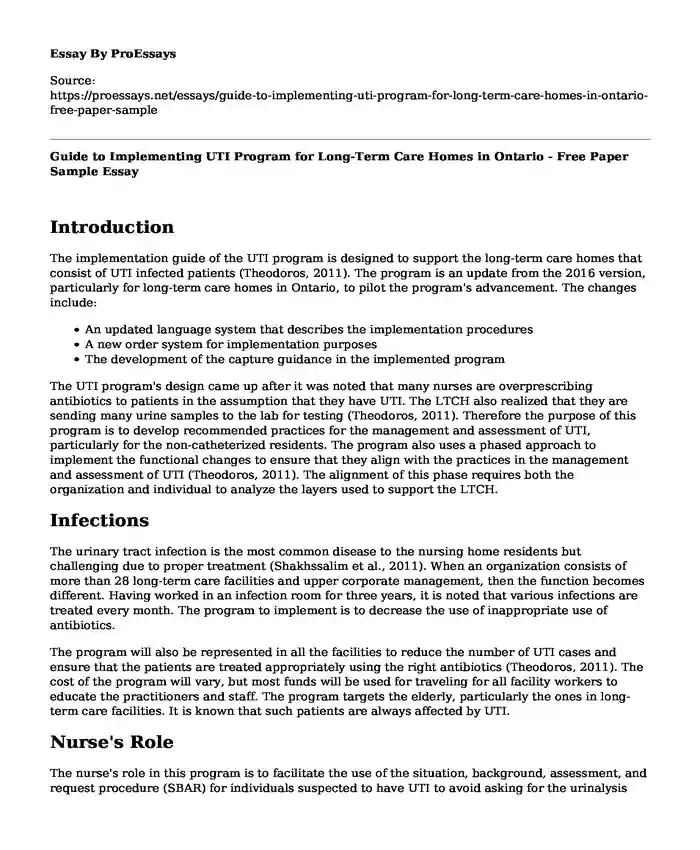Introduction
The implementation guide of the UTI program is designed to support the long-term care homes that consist of UTI infected patients (Theodoros, 2011). The program is an update from the 2016 version, particularly for long-term care homes in Ontario, to pilot the program's advancement. The changes include:
- An updated language system that describes the implementation procedures
- A new order system for implementation purposes
- The development of the capture guidance in the implemented program
The UTI program's design came up after it was noted that many nurses are overprescribing antibiotics to patients in the assumption that they have UTI. The LTCH also realized that they are sending many urine samples to the lab for testing (Theodoros, 2011). Therefore the purpose of this program is to develop recommended practices for the management and assessment of UTI, particularly for the non-catheterized residents. The program also uses a phased approach to implement the functional changes to ensure that they align with the practices in the management and assessment of UTI (Theodoros, 2011). The alignment of this phase requires both the organization and individual to analyze the layers used to support the LTCH.
Infections
The urinary tract infection is the most common disease to the nursing home residents but challenging due to proper treatment (Shakhssalim et al., 2011). When an organization consists of more than 28 long-term care facilities and upper corporate management, then the function becomes different. Having worked in an infection room for three years, it is noted that various infections are treated every month. The program to implement is to decrease the use of inappropriate use of antibiotics.
The program will also be represented in all the facilities to reduce the number of UTI cases and ensure that the patients are treated appropriately using the right antibiotics (Theodoros, 2011). The cost of the program will vary, but most funds will be used for traveling for all facility workers to educate the practitioners and staff. The program targets the elderly, particularly the ones in long-term care facilities. It is known that such patients are always affected by UTI.
Nurse's Role
The nurse's role in this program is to facilitate the use of the situation, background, assessment, and request procedure (SBAR) for individuals suspected to have UTI to avoid asking for the urinalysis from the physicians (Shakhssalim et al., 2011). The program will also eradicate the inappropriate use of antibiotics to improve the health of patients. Nurses will also be required to work with other healthcare professionals to ensure that all patients are given antibiotics in a proper prescription.
Every patient must go to the infection control nurse to ensure that all protocols are followed before being transferred to the clinicians.
Since the advocate will take care of the elderly who live in the nursing homes, he will also be responsible for facilitating the breeding grounds of antibiotics to refrain the ones that will be harmful (Theodoros, 2011). The primary focus is to eliminate medicine that patients don't require to the ones that have side effects. The design decisions of these prescriptions are that every tool kit informs UTI to be seen by the advocate before further instructions are released to the health care team (Theodoros, 2011). The infection control nurse's role will be to ensure that suspected patients that have the urinary tract infection can be assessed and assigned to the correct implementation (Shakhssalim et al., 2011). This will also depend on the behavior of residents who must go through the assessment before the physicians do the prescriptions of medicines.
The roles people in this program will also vary between the implementation and design of the healthcare programs. For instance, the nurses must ensure that the toolkit suspected UTI SBAR is followed before implementing further measures. This is because the tool consists of minimum criteria for the administration of the antibiotics (Shakhssalim et al., 2011). A suitable example is a patient that lacks the catheter symptoms and signs like a fever but experiences worsening or new suprapubic gross hematuria urinary incontinence, then they must undergo treatment.
Conclusion
Strong leadership is essential when it comes to the management of the health care system. For instance, in the nursing field, leaders must develop healthcare programs that validate the procedures done in the health care system. A good example is the UTI program, whose role is to eradicate the misuse of antibiotics in hospitals. Clinicians, advocates, and infection control nurses play a vital role in implementing the program and providing high quality service to the residents.
References
Shakhssalim, N., Samzadeh, M., & Mohammad, S. (2011). Complicated upper urinary tract infection. Urinary Tract Infections.
https://doi.org/10.5772/24189
Theodoros, K. (2011). Urinary tract immunology. Clinical Management of Complicated Urinary Tract Infection.
https://doi.org/10.5772/21939
Cite this page
Guide to Implementing UTI Program for Long-Term Care Homes in Ontario - Free Paper Sample. (2023, Oct 12). Retrieved from https://proessays.net/essays/guide-to-implementing-uti-program-for-long-term-care-homes-in-ontario-free-paper-sample
If you are the original author of this essay and no longer wish to have it published on the ProEssays website, please click below to request its removal:
- Essay Example on Public Health: Obesity Among Teenagers
- Socialism and Economic Liberalism - Essay Example on Economics
- Ethics in Heathcare Essay Example
- Revision on the PICOT for Nursing Burnout
- School Medical Care: Protecting At-Risk Children - Essay Sample
- Essay Example on COVID-19: Global Virus Spreads Through Droplets, 3800 US Cases, 69 Deaths
- Progressivism: Social Reform to Improve Lives - Essay Sample







